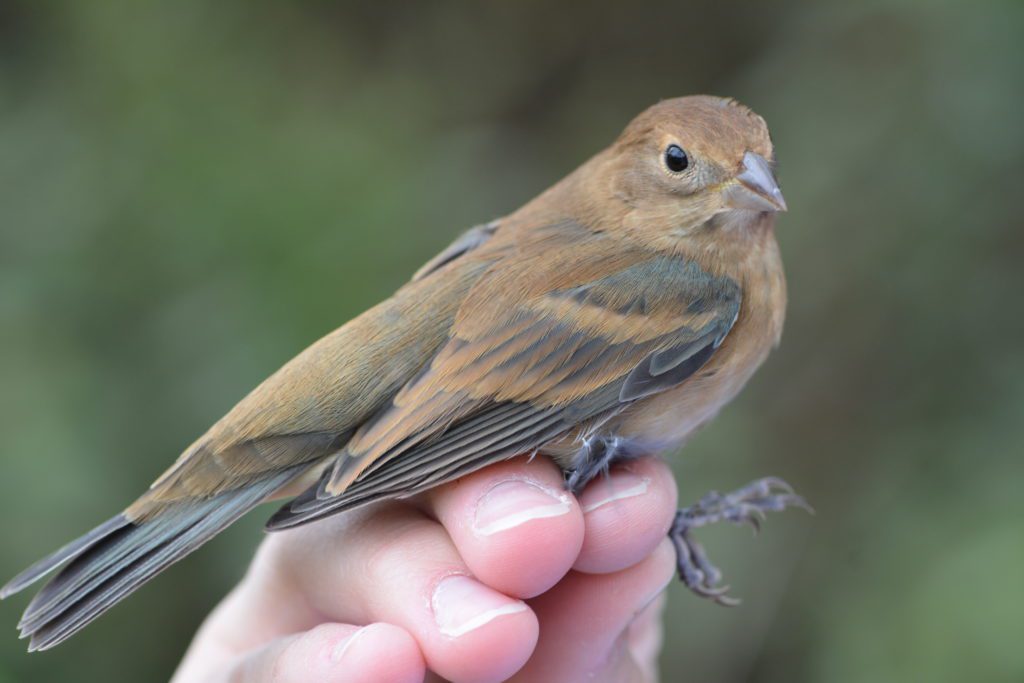by Mary Shidel, with special thanks to Pam Curtin, for her detailed history of the Powdermill Bird Banding Program

On June 18, 1961, a small brown bird with hints of blue on its wings and tail left its shrubby perch or perhaps its nest and flew into a soft nylon net. Little did this Indigo Bunting know that she would be the first data point in a long history of bird banding at the Powdermill Nature Reserve. Bob Leberman carefully extracted the bunting from the net, placed it in a bag for transport, then attached a small, almost weightless metal band to her leg, and collected data for age, sex, wing length and mass. Within minutes she was out flitting through the vegetation foraging for food. This same process has continued for 60 years, one bird at a time—capture, band, collect data, and release.

Powdermill Nature Reserve is the biological field station of Carnegie Museum of Natural History. In 1961, Bob Leberman, who had experience banding birds in Erie and near his hometown of Meadville, Pennsylvania, was hired by the museum’s director, Dr. Graham Netting, to establish a banding program at the Nature Reserve. Over the first decade or so the program evolved as Bob experimented with net sizes and placement, and honed skills and techniques for ageing and sexing that are still widely used today. In September 1961, a large pond was constructed and christened “Crisp Pond” after the village that used to exist nearby, and in 1975 two smaller ponds were added with shallower habitat for wading birds.

In the early days, Bob banded from mid-March to mid-November. It wasn’t until 1974, when a permanent residence was established at the reserve for him, that Bob became the first person in the country to band year-round. By 1970, as Bob’s research expanded, a nearby garage and service building were repurposed into a laboratory and office space for the Banding Program.
A 1967 publication of the Carnegie Museum notes that “one of the most valuable assets” of Powdermill Bird Banding is the “considerable effort made to keep data consistent and comparable.” This is still true sixty years later. Just as Bob did in the early days, nets are opened one half hour before sunrise and checked every forty minutes (or adjusted if necessary due to weather conditions). Nets are kept in the same exact location from year to year, and net lanes are trimmed frequently to keep the vegetation surrounding the nets in an early successional state rather than just letting the forest overtake the banding area.

Data consistency and integrity is also still paramount at the banding lab. Over the years, very few people have held the “bander in charge” position, and those collecting the data work closely to calibrate measurements and methods. Amazingly, of the 800,000 records now in the banding database, Bob Leberman, who retired in 2004, collected the data for almost half! In 1983, Bob Mulvihill, whose connection to the banding program began as a volunteer four years earlier, joined Bob Leberman as Powdermill’s second full-time bander. Through the efforts of both “Bobs” the program grew and expanded. In 2004, in a recognition of ongoing research projects beyond the scope of the bird banding program, the lab was renamed “Powdermill Avian research Center,” a name frequently abbreviated as PARC.
The number of people who have supported the banding program in small and great ways over the years is much too vast to name here, but the program could never have grown and flourished without the thousands of volunteer hours and strong support from the staff at both Carnegie Museum of Natural History and Powdermill Nature Reserve. Generous funding from private donors and foundations over the years has extended the influence of PARC both nationally and globally.

Today, PARC is under the direction of Lucas DeGroote, Avian Research Coordinator, with Annie Lindsay, Banding Program Manager, directing day-to-day operations at the Banding Lab. Countless avenues of research focus on finding new ways to help birds. Each banding day, Annie and her staff will be opening nets before sunrise, checking the nets every forty minutes, and safely collecting and measuring the birds, growing the database and avian knowledge, one bird at a time.
And so the tradition continues…
Mary Shidel is a Banding Assistant at Powdermill Nature Reserve, Carnegie Museum of Natural History’s environmental research center. Museum employees blog about their unique experiences and knowledge gained from working at the museum.
Related Content
Milestones at Powdermill’s Banding Lab
Carnegie Museum of Natural History Blog Citation Information
Blog author: Shidel, MaryPublication date: November 5, 2021
